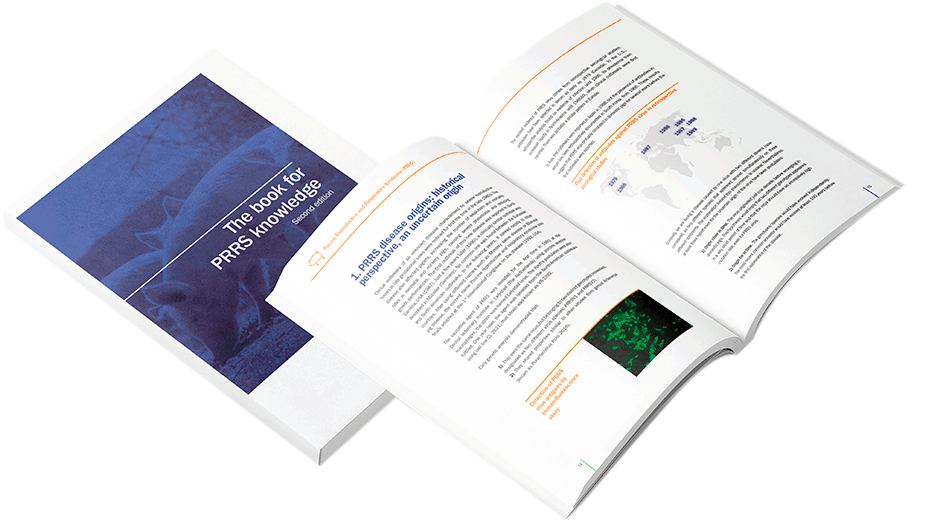We should remember that the protection means different things for virologists and practitioners and producers. The best is when immunization protects completely against the infection. This is rarely achieved in the field conditions.What we are aiming at, using immunization protocols, is to protect against the clinical symptoms, and restricting virus shedding and transmission. In other words we are aiming at clinical protection and limiting the virus presence in the farm environment.
The cross protection is best if induced by the strain that is used to challenge the pigs. Some scientific reports show that it can be lifelong, not only in terms of clinical symptoms but also can protect against the infection. The further away antigenically is the challenging virus from the immunizing virus, the lower is the cross protection. The problem is that we don’t know how to measure antigenic relationship between strains that would allow us to predict the level of cross protection (also vaccine induced).
Today there are modified live virus vaccines produced from multiple genetic lineages of either Type 1 or Type 2. In theory better protection is provided by the vaccine of the same genotype as the wild type virus. Genetic classification of the vaccine strain within the genotype is less important. However, there are reports showing good efficacy of “American” vaccines against “European” strains, and vice versa. We have to remember that the vaccination efficacy is a result of the vaccine antigenicity, vaccination technique, the properties of the wild type strain and its dose (the presence in the environment).
All these factors influence the outcome of the vaccination protocol. “Weak” vaccine could be good enough if properly administered in animals staying in clean pens and are fed well. “Strong” vaccine will not work if administered as split dose, in animals living in poor conditions, coinfected with other pathogens that may compromise their immune system, and in a population of mixed immune status regarding PRRSV. Large farms can be coinfected with multiple strains of PRRSV. It is good to know it, and to monitor the changes in virus populations during the control programs.
In summary, the differences in immunogenicity between the vaccines do exist but in the field conditions the most important is to be consistent in executing the vaccination program with a given vaccine, to improve management practices and to monitor the effects of the program in terms of changes in virus circulation (laboratory diagnosis) as well as in terms of production parameters.
You can ask your own question! Visit Pig333.com and submit your question to our experts.
¿Qué diferencias hay entre las vacunas frente a PRRS tipo 1 y tipo 2 respecto a la inmunidad que generan en las cerdas?
Debemos recordar que la definición de protección es distinta para virólogos, veterinarios clínicos y productores. La mejor inmunización es la que protege completamente contra la infección, pero esto no se suele conseguir en situaciones de campo. Con los protocolos de inmunización pretendemos proteger frente a los síntomas clínicos y limitar la excreción y transmisión del virus. En otras palabras, nos centramos en la protección clínica y en limitar la presencia del virus en el ambiente de la granja.
La protección cruzada funciona mejor si está inducida por la cepa utilizada para desafiar a los cerdos. Algunos artículos científicos demuestran que puede ser de por vida, no sólo por lo que respecta a los síntomas clínicos sino que también pueden proteger contra la infección. Cuanto mayor sea la distancia antigénica entre el virus desafiante y el inmunizante, peor será la protección cruzada. El problema es que no sabemos cómo medir la relación antigénica entre cepas que nos permitiría predecir el nivel de protección cruzada (también la inducida por la vacuna).
Actualmente hay vacunas de virus vivos modificados producidas a partir de múltiples linajes genéticos tanto de tipo 1 como 2. En teoría la vacuna del mismo genotipo que el virus salvaje proporciona una mejor protección. La clasificación genética de la cepa vacunal dentro del genotipo no es tan importante. Sin embargo hay artículos que demuestran buena eficacia de las vacunas “americanas” frente a cepas “europeas” y viceversa. Debemos recordar que la eficacia de la vacunación es el resultado de la capacidad antigénica de la vacuna, la técnica de vacunación, las propiedades de la cepa salvaje y su dosis (su presencia en el ambiente).
Todos estos factores afectan al resultado del protocolo vacunal. Una vacuna “débil” puede ser suficientemente buena si se administra adecuadamente en animales alojados en ambientes limpios y bien alimentados, mientras que una vacuna “potente” no funcionará si se administra a una dosis inferior, en animales que viven en malas condiciones, con coinfecciones por otros patógenos que pueden comprometer su sistema inmune y en una población en la que se mezclan animales con diversas inmunidades frente a PRRS. Las granjas grandes pueden coinfectarse con varias cepas de PRRSv. Es bueno saberlo, y monitorizar los cambios de las poblaciones víricas durante los programas de control.
En resumen, si bien hay diferencias entre vacunas respecto a su capacidad para generar inmunidad, en condiciones de campo lo más importante es llevar a cabo un programa vacunal consistente, mejorar las prácticas de manejo y monitorizar los efectos del programa respecto a cambios en la circulación viral (diagnóstico laboratorial) y a parámetros productivos.
Puedes formular tu propia pregunta! Visita 3tres3.com e introduce allí tu pregunta a los expertos.

Warsaw University of Life Sciences – Poland



